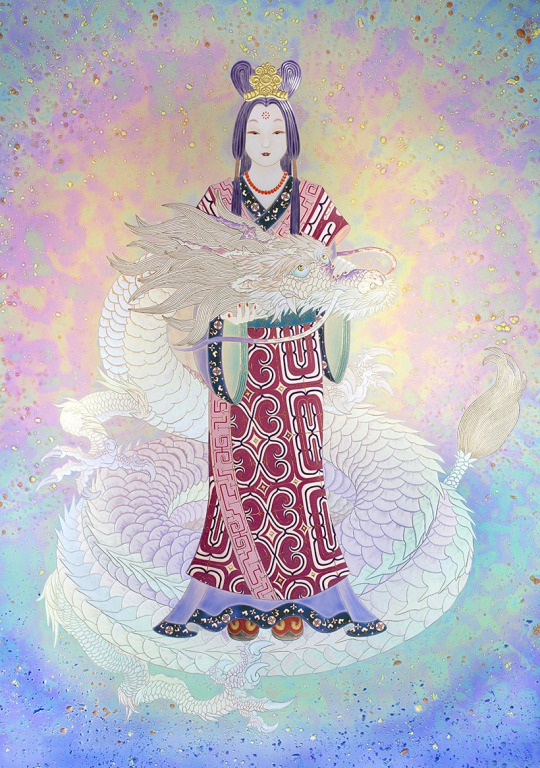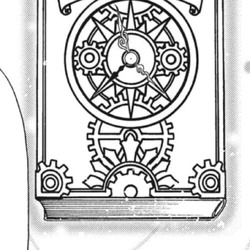Your go-to destination for in-depth reviews, thoughtful analyses, and bold theories on all your favorite Clamp works— You being here is no coincidence, only hitsuzen.
Don't wanna be here? Send us removal request.
Text
xxxHolic Rei - Chapter 60 Review

Starting with the cover, we see what appears to be Yuuko in a beautiful wedding dress, as pointed out by chibiyuuto in his analysis—go check it out.
The headpiece is very reminiscent of Watanuki’s symbol, which, as revealed in Rei, is a bird.
Given the similarity to the client hosted in the shop (the copy/doppelgänger of the Zashiki-Warashi), I thought it might be her—but the symbolism seems to point to it really being Yuuko.
It’s poetic that, having had her time frozen by the mage Clow, she remained “unblemished,” just like a bride.
It’s curious to note the editor’s note here: “Do you intend to become Watanuki’s enemy, even though he’s trying to save the Zashiki-Warashi?” It makes sense when you consider that we actually don’t know whose objective that line refers to—Seoritsu‑hime? Someone else?
At the beginning of the chapter, we have Haruka‑san speaking with Watanuki in a dream. In Japanese, naming conventions are deeply rooted in cultural values and traditions, often reflecting meanings related to nature, virtue, and family history.
We saw in earlier chapters that Watanuki didn’t want Dōmeki to take on the responsibility of naming the “Book,” and for good reason. Depending on how things unfold, Dōmeki may not be able to just stand by and watch, since he’s now involved.
It’s worth remembering that Dōmeki has a purifying aura that acts like a repellent to spiritual forces in the world around him that might do harm to him or those close to him—so his witnessing this must have greater importance later on.
About Seoritsu‑hime In the traditional version, she is a goddess of purification, water, and rain, associated with the Aramatsuri-no-miya shrine at Ise Jingū. Her figure was syncretized with Hashihime and recognized as a purifying deity in Shinto rituals.

Meanwhile, Hashihime in Heian literature is portrayed as a lonely woman awaiting her lover. Over time, she came to be seen either as a bridge‑protecting spirit or a feared jealous kijo. Her legend is tied to a famous bridge in Uji.
So, at Hashihime-jinja, Seoritsu‑hime is syncretized with Hashihime, becoming a protective deity of bridges. In the context of traditional Shinto, Seoritsu‑hime is a goddess who purifies waters, linked to rites of spiritual cleansing and venerated in various shrines.
That’s exactly why, when Momo/Seoritsu‑hime is spying on Watanuki’s dream, she says she doesn’t feel that kind of thing (not liking to be compared to the version where the princess is jealous).

Seoritsu‑hime explains that she is not a Yumemi like Watanuki. By the way, “Yumemi” can be translated as dream gazer or observer, but it carries a sense of seer—so in English you often see it as Dream Gazer or Dream Seer.
In fact, this interaction reminded me a bit of Kanoe from the manga X. If I recall correctly, Kanoe has the ability to spy on her sister Princess Hinoto’s dreams—an interesting parallel.

Another curiosity: the word 本 (hon) generally means “book,” but in this context it appears inside Japanese quotation marks 『』 and refers to a magical entity—an object with consciousness or a symbol of destiny/power.
When we translate directly, the line:
“I, too, am that kind of existence—the ‘Book.’”
The kanji used is 『本』 (“book”)—an object. However, the furigana (the reading above or beside the kanji) indicates “ワタシ” (watashi)—“I.”
This creates a semantic play: visually it shows “book,” but phonetically it reads “I.” So I chose to translate it by keeping “Book” as an apposition in order not to lose the meaning.
And here’s my favorite panel. Seoritsu‑hime refers to the time she spent as a mascot and how uncomfortable it was. We can then suppose that what we see now in xxxHolic Rei takes place after the events of Cardcaptor Sakura – Clear Card.
By the way, for those who don’t know, Momo is a character from the final arc of Cardcaptor Sakura and is crucial to the story. Seeing her again in xxxHolic really makes us want to know what’s happening with Akiho and Kaito, right?


She even mentions that she too is a type of “existence” created by someone and that such creation logically came at a price. Who could have created her/the Book? Honestly, I have no solid theory, although many suppose it might have been Yuuko herself.

Back in Sakura, we know that the “Book” grants its owner command over a special kind of magic: temporal magic, for those who form a contract with it. In Sakura, the Book even had hands (clock pointers). In Holic, they’re no longer there.
We should learn more about what the Book can do in the next chapters. Could it adapt its form to the person it contracts with? The last person to contract with it was Yuna D. Kaito, and his need for temporal magic may explain this current form.

It was a short chapter, and I ended up not commenting on chapters 57 to 59, but the core of the Zashiki‑Warashi must be approaching soon—so I’ll be back to comment more. Hope you enjoyed it!
0 notes
Text
Análise do Capítulo 60 de xxxHolic Rei

Vamos lá!
Começando pela capa, temos o que parece ser a Yuuko num belo vestido de noiva como apontado pelo chibiyuuto na análise dele, inclusive vão lá conferir.
For the english review, please read it here.
O adorno na cabeça lembra muito o símbolo do Watanuki, que como foi revelado em Rei, é um pássaro.
Dada a similaridade da cliente hospedada na loja (a cópia/sósia da Zashiki-Warashi) pensei que poderia ser ela, mas o simbolismo parece indicar ser a Yuuko mesmo. Poético que por ter tido seu tempo congelado pelo mago Clow, ela permaneceu "imaculada", assim como uma noiva.
É curioso notar aqui a nota do editor que fala "Você pretende se tornar inimiga de Watanuki, que está tentando salvar a Zashiki-Warashi?", mas faz sentido se paramos para pensar que de fato não sabemos o objetivo da pessoa a quem essa fala se refere? Seoritsu-hime? Outro?
No começo do capítulo temos Haruka-san, conversando com Watanuki em um sonho. No japonês, as convenções de nomenclatura estão profundamente enraizadas em valores e tradições culturais, muitas vezes refletindo significados relacionados à natureza, virtude e história familiar.
Vimos nos capítulos anteriores que Watanuki não queria que Doumeki tivesse a responsabilidade de dar um nome ao "Livro", e é justamente por isso. E dependendo de como as coisas se desenrolarem, Doumeki não poderá simplesmente observar, já que agora ele está envolvido.
É bom lembrarmos que Doumeki tem uma aura purificadora que age como um repelente para as forças espirituais do mundo ao seu redor que possam causar mal a ele ou àqueles ao seu redor, então certamente ele ter sido testemunha deve ter alguma importância maior mais para frente.
Sobre Seoritsu-hime, na versão tradicional, ela é uma deusa da purificação, água e chuva, ligada ao santuário Aramatsuri no miya em Ise-jingu. Sua figura foi sincretizada com Hashihime e reconhecida como uma divindade purificadora nos ritos shintoístas.

Já Hashihime na literatura Heian como uma mulher solitária esperando seu amado. Com o tempo, passou a ser vista como um espírito protetor de pontes ou uma temida kijo, movida pelo ciúme. Sua lenda está ligada a uma famosa ponte em Uji.
Ou seja, em Hashihime-jinja, Seoritsu-hime é sincretizada com Hashihime, tornando-se uma divindade protetora das pontes. No contexto do Shinto tradicional, Seoritsu-hime é uma deusa purificadora das águas, ligada a ritos de limpeza espiritual e venerada em vários santuários.
É exatamente por isso que quando Momo/Seoritsu-hime está espiando o sonho de Watanuki, ela fala que não sente esse tipo de coisa. (Não gostando de ser comparada à versão onde a princesa é ciumenta)

Seoritsu-hime explica que não é uma Yumemi, como Watanuki. Aliás, Yumemi pode ser traduzido como contemplador de sonhos, observador, mas carrega um sentido de vidente, tanto que em inglês é comum encontrar a tradução como Dream Gazer ou Dreem Seer.
Inclusive, essa interação me lembrou um pouco de Kanoe, do mangá X. Lá, se a memória não me falha, a Kanoe tem a habilidade de espiar os sonhos da irmã, a princesa Hinoto, achei interessante ter me lembrado disso.

Outra curiosidade, a palavra 本 (hon) geralmente significa “livro”, mas no contexto analisado, aparece entre aspas japonesas 『』 e refere-se a uma entidade mágica, objeto com consciência ou símbolo de destino/poder.
Quando traduzirmos diretamente, a frase:
“Eu também sou esse tipo de existência — o ‘Livro’.”
O kanji usado é 『本』 (“livro”) — um objeto.
No entanto, o furigana (leitura adicionada acima ou ao lado do kanji) está indicando “ワタシ” (watashi) — “eu”.
Isso cria um jogo semântico:
Visualmente é “livro”, mas foneticamente é “eu”. Então optei por traduzir mantendo o "livro" como aposto para não perder o sentido.
E meu painel favorito aqui. Seoritsu-hime aqui se refere ao tempo que passou como mascote, e como era desconfortável. Podemos então supor que realmente o que vemos agora em xxxHolic Rei se passa após os acontecimentos de Cardcaptor Sakura - Clear Card.

Aliás, pra quem não conhece, Momo é personagem do último arco de Cardcaptor Sakura e crucial pra história. Rever essa personagem aqui em xxxHolic meio que deixa a gente com vontade de saber da Akiho e do Kaito, né?


Ela inclusive comenta que também é um tipo de "existência" criada por alguém, e que essa criação logicamente custou um preço. Quem teria criado ela/o livro? Honestamente, não tenho teorias, por mais que muitos suponham que possa ter sido a própria Yuuko.

Lá em Sakura, aliás, sabemos que o "Livro" é capaz de conceder ao seu dono o comando de um tipo especial de mágica: magia temporal, para aqueles que fazem um contrato com ele. Lá, inclusive, o Livro tinha ponteiros. Em Holic eles não estão mais lá.

Devemos saber mais sobre o que o livro é capaz nos próximos capítulos. Será que ele pode se moldar de acordo com a pessoa com quem faz o contrato? A última pessoa a ter um contrato foi Yuna D. Kaito, e a necessidade dele por magia temporal pode ter sido o motivo para esta forma.
Foi um capítulo curto, e acabei não comentando sobre os capítulos 57 ao 59, mas o núcleo da zashiki-warashi deve andar em breve e então eu volto para comentar mais. Espero que curtam.
2 notes
·
View notes